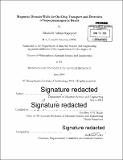| dc.contributor.advisor | Geoffrey S. D. Beach. | en_US |
| dc.contributor.author | Rapoport, Elizabeth Ashera | en_US |
| dc.contributor.other | Massachusetts Institute of Technology. Department of Materials Science and Engineering. | en_US |
| dc.date.accessioned | 2014-09-19T21:31:16Z | |
| dc.date.available | 2014-09-19T21:31:16Z | |
| dc.date.copyright | 2014 | en_US |
| dc.date.issued | 2014 | en_US |
| dc.identifier.uri | http://hdl.handle.net/1721.1/89960 | |
| dc.description | Thesis: Ph. D., Massachusetts Institute of Technology, Department of Materials Science and Engineering, 2014. | en_US |
| dc.description | Cataloged from PDF version of thesis. | en_US |
| dc.description | Includes bibliographical references (pages 121-130). | en_US |
| dc.description.abstract | Surface-functionalized superparamagnetic (SPM) microbeads are of great interest in biomedical research and diagnostic device engineering for tagging, manipulating, and detecting chemical and biological species in a fluid environment. At the same time, lab-onchip technologies have grown popular due to their many advantages, including small sample volume requirements, sensitivity, portability, and speed. As such, there has been a steady progression in the advancement of magnetic technologies for bead manipulation in chipbased devices. Given the non-volatility and fast speeds of magnetic domain walls (DWs), their study has been largely driven by their application to information technology. In this work, the use of magnetic DWs for superparamagnetic bead capture and manipulation was investigated and extended. The interaction and dynamics between SPM beads and DWs is described and thoroughly characterized, and it is demonstrated that, owing to their highly localized stray fields, DWs in magnetic tracks can be used to shuttle individual SPM microbeads and magnetically tagged entities across the surface of a chip. Indeed, fast transport around prototype ring structures and long distance translation along curvilinear backbones is demonstrated. Moreover, it is shown that the bead-DW interaction can be further exploited to achieve programmable manipulation of a bead at a junction in a branched curvilinear structure, enabling bead sorting and the design of complex bead routing networks. A method for DW-based SPM bead detection in these same structures is proposed and discrimination amongst commercial bead populations based on magnetomechanical resonance is demonstrated. Thus, a DW-based technique is demonstrated that achieves a complete set of essential SPM bead handling capabilities, including capture, transport, identification, and release, required for an integrated magnetic lab-on-chip platform. | en_US |
| dc.description.statementofresponsibility | by Elizabeth Ashera Rapoport. | en_US |
| dc.format.extent | 130 pages | en_US |
| dc.language.iso | eng | en_US |
| dc.publisher | Massachusetts Institute of Technology | en_US |
| dc.rights | M.I.T. theses are protected by copyright. They may be viewed from this source for any purpose, but reproduction or distribution in any format is prohibited without written permission. See provided URL for inquiries about permission. | en_US |
| dc.rights.uri | http://dspace.mit.edu/handle/1721.1/7582 | en_US |
| dc.subject | Materials Science and Engineering. | en_US |
| dc.title | Magnetic domain walls for on-chip transport and detection of superparamagnetic beads | en_US |
| dc.type | Thesis | en_US |
| dc.description.degree | Ph. D. | en_US |
| dc.contributor.department | Massachusetts Institute of Technology. Department of Materials Science and Engineering | |
| dc.identifier.oclc | 890128957 | en_US |
